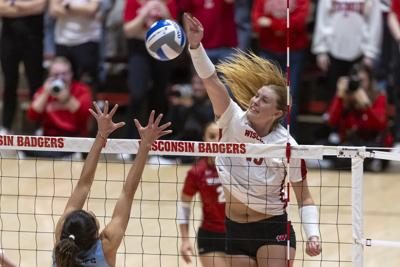The college sports world has been in a state of constant change over recent years with the advent of the transfer portal and name, image and likeness, not to mention major changes in recruiting rules.
Like them or not, University of Wisconsin volleyball coach Kelly Sheffield knows that the most successful programs are those which adapt to these changes.
This is the third recruiting season under the new limitations that don’t allow coaches to contact recruits until June 15 after their sophomore year. That was designed to eliminate the trend of recruiting younger and younger players that saw a couple seventh or eighth graders committing each year.
People are also reading…
“The rules that we have right now, I think there was good intent behind it,” Sheffield said. “But I don’t think you should restrict open dialog. I think that makes it tougher on families.”
Under the new rules, a majority of players have committed in the first few weeks, before they are allowed to take official or unofficial campus visits beginning on August 1. Those who do hold off often wait until school starts and matches are played in September.
Wisconsin has been active in the transfer portal over the years, bringing in a number of key contributors. The current 2024 roster has four transfers — Sarah Franklin, Caroline Crawford, Carter Booth and Carly Anderson — among its 15 players.
Sheffield is open to all methods of bringing talent into the program but doesn’t intentionally keep a scholarship open for potential transfers.
“I think it’s always good to have flexibility,” he said. “But we want players that fit, whether that is somebody coming out of high school or somebody coming from another program. If the fits happen to be a lot of high school players, then that’s how the roster is. If it happens to be a lot of international players, then that’s it. If it happens to be a lot of transfers, then that’s it.
“Given the choice you’d rather have a player for four or five years. There are a lot of advantages to that. But we’re not thinking that’s the only way that we’re going to recruit.”

Wisconsin's Sarah Franklin transferred from Michigan State and developed into the Badgers' second national player of the year.
Looking ahead, Sheffield sees the possibility of the current 12-scholarship limit expanding as part of the recent NCAA legal settlement that could allow conferences or individual schools to determine the number of scholarships per sport.
“I would anticipate a lot of schools’ roster sizes will look a lot different than it does now by the time this class starts college,” he said.
As for NIL, Sheffield said it’s not the high profile issue in volleyball that it has become in football and basketball. And while NIL is not necessarily a conversation starter with recruits, it’s also not something he avoids when it comes up.
“I would just say that if somebody is going somewhere because of the money, they’re not going to be a fit for our program,” Sheffield said. “But I would say that when you go to a program that has a pretty large fan base and a passionate following, the opportunities for NIL are a lot higher than for programs that don’t have much of a following.
“We have not entered a pay-for-play type of deal here with our program. What schools are and will there be more of that going in, I think we’ll find out in a couple weeks?
“We don’t shy away from NIL. It’s a great opportunity that student-athletes have. It would be foolish for us to not talk about what their opportunities are, but it also would be a red flag if that’s the only reason why people are making their decision. So it’s part of it, but it’s certainly not how we’re leading off the conversation. There’s so much more interesting things to talk about.”
Photos: Wisconsin volleyball spring game vs University of Illinois Chicago

Wisconsin Badgers Sarah Franklin (13) spikes the ball during the second set against the University of Illinois Chicago at the UW Field House in Madison, Wis., Friday, April 19, 2024. SAMANTHA MADAR,STATE JOURNAL

Wisconsin's Julia Orzol high-fives fans before the match.

Wisconsin's Anna Smrek goes for the spike during the first set.

“It was one of the best experiences of my volleyball career," Wisconsin setter Carly Anderson said of the atmosphere Friday night at the UW Field House.

Wisconsin Badgers Devyn Robinson (10) celebrates during the second set of the spring match at the UW Field House in Madison, Wis., Friday, April 19, 2024. SAMANTHA MADAR,STATE JOURNAL

Wisconsin Badgers Julia Orzol (22) tips the ball during the second set of the spring match at the UW Field House in Madison, Wis., Friday, April 19, 2024. SAMANTHA MADAR,STATE JOURNAL

Wisconsin Badgers Sarah Franklin (13) celebrates with Julia Orzol (22) and Gulce Guctekin (21) during the second set of the spring match at the UW Field House in Madison, Wis., Friday, April 19, 2024. SAMANTHA MADAR,STATE JOURNAL

Fans arrive to the UW Field House for the Badger volleyball spring match against University of Illinois at the in Madison, Wis., Friday, April 19, 2024. SAMANTHA MADAR,STATE JOURNAL

Wisconsin Badgers Devyn Robinson (10), Saige Damrow (3) and Carter Booth (52) dance behind a teammate’s interview before the spring match at the UW Field House in Madison, Wis., Friday, April 19, 2024. SAMANTHA MADAR,STATE JOURNAL

Wisconsin Badgers setter Carly Anderson (4) sets teh ball during the third set against the University of Illinois Chicago at the UW Field House in Madison, Wis., Friday, April 19, 2024. SAMANTHA MADAR,STATE JOURNAL

Wisconsin Badgers Devyn Robinson (10) bumps the ball during the third set against the University of Illinois Chicago at the UW Field House in Madison, Wis., Friday, April 19, 2024. SAMANTHA MADAR,STATE JOURNAL

Wisconsin Badgers Sarah Franklin (13) approaches the ball during the third set against the University of Illinois Chicago at the UW Field House in Madison, Wis., Friday, April 19, 2024. SAMANTHA MADAR,STATE JOURNAL

The Wisconsin Badgers huddle together during the third set against the University of Illinois Chicago at the UW Field House in Madison, Wis., Friday, April 19, 2024. SAMANTHA MADAR,STATE JOURNAL

Wisconsin Badgers Devyn Robinson (10) runs off the court after defeating the University of Illinois Chicago in a spring match at the UW Field House in Madison, Wis., Friday, April 19, 2024. SAMANTHA MADAR,STATE JOURNAL

Wisconsin Badgers Gulce Guctekin (21), Julia Orzol (22) and Anna Smrek (14) run off the court after defeating the University of Illinois Chicago in a spring match at the UW Field House in Madison, Wis., Friday, April 19, 2024. SAMANTHA MADAR,STATE JOURNAL

Wisconsin Badgers Julia Orzol (22) bumps the ball during the first set against the University of Illinois Chicago at the UW Field House in Madison, Wis., Friday, April 19, 2024. SAMANTHA MADAR,STATE JOURNAL

Wisconsin Badgers setter Carly Anderson (4) celebrates with teammates during the first set against the University of Illinois Chicago at the UW Field House in Madison, Wis., Friday, April 19, 2024. SAMANTHA MADAR,STATE JOURNAL

Wisconsin Badgers Julia Orzol (22) tips the ball during the first set against the University of Illinois Chicago at the UW Field House in Madison, Wis., Friday, April 19, 2024. SAMANTHA MADAR,STATE JOURNAL

Wisconsin Badgers Carter Booth (52) celebrates during the first set against the University of Illinois Chicago at the UW Field House in Madison, Wis., Friday, April 19, 2024. SAMANTHA MADAR,STATE JOURNAL

Wisconsin Badgers Saige Damrow dances (3) during the second set against the University of Illinois Chicago at the UW Field House in Madison, Wis., Friday, April 19, 2024. SAMANTHA MADAR,STATE JOURNAL

Wisconsin Badgers head coach Kelly Sheffield applauds to the fans after the match against the University of Illinois Chicago at the UW Field House in Madison, Wis., Friday, April 19, 2024. SAMANTHA MADAR,STATE JOURNAL










































